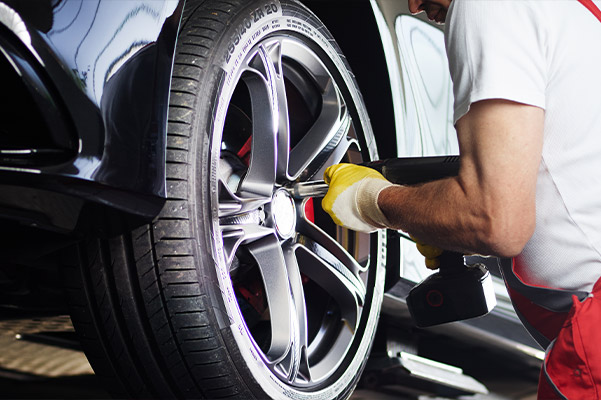Tire Service: The Effect of Climate Condition
When it involves guaranteeing optimum performance and safety and security when driving, recognizing the impact of climate condition on tire service is essential. From scorching warmth to icy roadways, each climate component can dramatically affect tire functionality and overall driving experience. By delving into the results of differing weather on tires, vehicle drivers can get valuable understandings that may boost their car's performance and durability. In this conversation, we will check out the detailed partnership between weather and tire service, clarifying the relevance of weather-specific tire maintenance methods and factors to consider.
Warmth and Tire Performance
When subjected to high temperature levels, tires experience changes in performance that can dramatically affect car safety and security and handling. The warmth produced from prolonged driving or heat conditions triggers the tire rubber to soften, resulting in decreased tread life and enhanced wear. As the rubber comes to be softer, the tire's hold on the road lessens, affecting stopping distances and overall traction. In severe instances, extreme warmth can also cause tire blowouts, presenting an extreme safety risk to the lorry and its residents.

Winter Impacts
Cold weather conditions can have a considerable effect on tire performance and safety and security. In cool climate, tires might additionally shed air stress a lot more rapidly, which can affect handling and fuel efficiency.
To alleviate the results of winter on tires, it is important to frequently check tire pressure and inflate them to the manufacturer's suggested degrees. Utilizing winter season or all-season tires made for winter conditions can likewise boost grip and hold on icy or snowy roads. Correct tire maintenance, consisting of routine inspections for wear and damages, becomes also much more important during chillier months to ensure optimal efficiency and security.
Rainy Issues Effect
Tires with worn-out footsteps are much more vulnerable to hydroplaning, where a layer of water constructs up between the roadway and the tire surface area, leading to loss of traction. To fight this, chauffeurs must consistently inspect their tires for ample walk depth and think about investing in tires specifically designed for damp problems.
Additionally, wet weather can likewise reduce presence, making it testing for drivers to see the road ahead plainly (GMC Tire Service). In such problems, it is necessary to adjust driving rates as necessary and preserve a secure complying with range to permit abrupt quits. Appropriately inflated tires can likewise help in keeping control on wet roads by giving much better handling and hold
Snow and Tire Safety And Security
When driving in snowy problems, having the appropriate tires can click here for more info make a substantial difference in security and efficiency. Winter season tires are developed with special rubber substances and tread patterns to supply far better grip on snow and ice compared to all-season tires.

In addition, vehicle drivers need to take into consideration setting up tire chains in extreme snowy conditions. Tire chains supply additional grip by clutching the snow and ice, improving stability and control. It is important to follow supplier instructions when utilizing and mounting tire chains to avoid damage to the tires and vehicle (GMC Tire Service). By picking the best tires, preserving appropriate inflation, and thinking about added traction help like tire chains, motorists can improve their safety when browsing snow-covered roadways.
Weather-Related Tire Upkeep
When faced with numerous climate conditions, appropriate tire maintenance becomes a critical element of car safety and efficiency. Weather-related tire upkeep encompasses a variety of practices focused on making sure ideal tire feature and long life in various climate situations. One vital aspect of weather-related tire upkeep is tire pressure regulation. Changing temperatures can trigger tire pressure to vary, impacting traction and fuel efficiency. On a regular basis inspecting and changing tire pressure according to manufacturer referrals is vital for safe driving in altering climate condition. Additionally, tire tread deepness plays a significant duty in taking care of different weather condition aspects. Tires with adequate step deepness give far better grasp on damp or icy roads, lowering the threat of skidding or hydroplaning. Inspecting tire step routinely and changing tires when walk wear gets to a specific deepness is crucial for maintaining traction and stability in damaging weather. By prioritizing weather-related tire upkeep, chauffeurs can boost safety, boost vehicle performance, and extend the life-span of their tires.
Final Thought
To conclude, weather condition conditions have a considerable influence on tire efficiency and safety. From warmth influencing tire stress and wear to winter minimizing grip, it is vital to think about the weather condition when preserving and using tires. Wet problems can reduce grip and result in hydroplaning, while snow can enhance the danger of crashes if tires are not properly outfitted. Weather-related tire upkeep is crucial original site in ensuring ideal performance and safety and security on the roads.
In this conversation, we will discover the detailed partnership between climate conditions and tire service, dropping light on the relevance of weather-specific tire upkeep methods and considerations.
